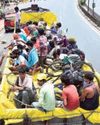The rocky terrain of Madhya Pradesh’s Neemuch district has emerged as the largest solar power-generating hub in India, but the nomadic communities that have lived there for generations find themselves dispossessed of land and reduced to abject poverty.

THE Jawaharlal Nehru National Solar Mission, launched in 2010 by the then Prime Minister, Manmohan Singh, as part of India’s plan to combat climate change, is considered one of Prime Minister Narendra Modi’s current pet projects. Across the country, States (especially those governed by the Bharatiya Janata Party [BJP]) have been vying—at least on paper—in the race to achieve the revised target of 1,00,000 megawatts (MW) by 2022. Large tracts of land have been earmarked for the setting up of exclusive solar power parks, and plans are afoot to amend land use regulations and tenancy laws in order to facilitate aggregation and leasing of land by farmers/developers for these projects.
In order to understand the impact of one such solar power project set up by Welspun in 2013,Frontline visited Neemuch district in Madhya Pradesh.
Located 60 kilometres from Mandsaur, the nerve centre of farmers’ protests across the country in June, the village of Bhagwanpura in Neemuch district is home to over 200 families from the Adivasi/nomadic communities of Gurjars and Bhils. For generations, they had grazed their cattle on government land, subsisted on rain-fed corn and jowar and water drawn from the ponds nearby, lived in homes hewn out of the rocky terrain, and worshipped their gods in little stone shrines. In short, they had been self-sufficient communities who lived well within their means, and with dignity.
この記事は FRONTLINE の August 18, 2017 版に掲載されています。
7 日間の Magzter GOLD 無料トライアルを開始して、何千もの厳選されたプレミアム ストーリー、9,000 以上の雑誌や新聞にアクセスしてください。
すでに購読者です ? サインイン
この記事は FRONTLINE の August 18, 2017 版に掲載されています。
7 日間の Magzter GOLD 無料トライアルを開始して、何千もの厳選されたプレミアム ストーリー、9,000 以上の雑誌や新聞にアクセスしてください。
すでに購読者です? サインイン

How Not To Handle An Epidemic
The lockdowns were meant to buy time to put in place appropriate health measures and contain the coronavirus’ spread, but they have failed to achieve the objective and heaped immense misery on the marginalised sections of society. India is still in the exponential phase of the COVID-19 infection and community transmission is a reality that the government refuses to accept.

Tragedy on foot
As the COVID-19-induced lockdown cuts the ground beneath their feet in Tamil Nadu, thousands of migrant workers are trudging along the highway to the relative safety of their upcountry homes.

Sarpanchs as game changers
Odisha manages to keep COVID-19 well under control because of the strong participation of panchayati raj institutions and the community at the grass-roots level under the leadership of Chief Minister Naveen Patnaik.

Scapegoating China
As the COVID-19 death rate spikes and the economy tanks in the United States, Donald Trump and his advisers target China and the World Health Organisation with an eye to winning the forthcoming presidential election.

New worries
Kerala’s measured approach to the pandemic and lockdown has yielded results. But it still has to grapple with their huge economic impact on its economy, which it feels the Centre’s special financial relief package does little to alleviate.
No love lost for labour
Taking advantage of the lockdown and the inability of workers to organise protests, many State governments introduce sweeping changes to labour laws to the detriment of workers on the pretext of reviving production and boosting the economy.

Capital's Malthusian moment
In a world that needs substantial reorienting of production and distribution, Indian capital is resorting to a militant form of moribund neoliberalism to overcome its current crisis. In this pursuit of profit, it is ready and willing to throw into mortal peril millions whom it adjudicates as not worth their means—an admixture of social Darwinism born of capital’s avarice and brutalism spawned by Hindutva. .

Understanding migration
When governments and their plans are found to be blatantly wanting in addressing reverse migration, exercises such as the Ekta Parishad’s survey of migrant workers throughout India can be useful to work out creative long-lasting solutions.

Waiting for Jabalpur moment
The Supreme Court’s role in ensuring executive accountability during the ongoing lockdown leaves much to be desired. Standing in shining contrast is the record of some High Courts.

An empty package
The Modi regime, which has been unable to control the COVID-19 infection, restore economic activity and provide relief to millions exposed to starvation, trains its sights on Indian democracy, making use of the panic generated by fear and a lockdown that forecloses paths of resistance.